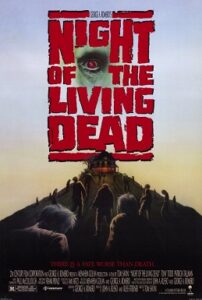.
In 1968 when George A. Romero released the extinction level event movie Night of the Living Dead and altered the cinematic landscape forever an editing mistake when the titles were changed dropped the film into the public domain robbing him of his justified rewards for such an original creation.
In the late 80s, working with his original producer John Russo and his talented make-up special effects artist Tom Savini he produced a remake of the film in hopes of pulling the original back into copyright. Romero failed to achieve his legal goal but did release in 1990 the newly envisioned Night of the Living Dead.
The bones of the original are the bones of the remake. A disparate collection of characters take refuge in an isolated farmhouse as a mass of undead reanimated corpses lay siege seeking to devour their living flesh.
Led by Patricia Tallman as Barbara and Tony Todd as Ben the plot and for all intents and purposes the characters are the same as the ’68 version. Mr. Cooper remains the principal human antagonist with his wife Helen more of a placeholder than a character and their injured daughter Sarah the ticking undead bomb within the building. Tommy and Judy, the young couple caught in the disaster have a little more to do this time around, though Judy’s (Katie Finneran) high pitched screams grew tiresome quite quickly and she was unconvincing as someone who supposedly knew their way around a truck and its operation.
Patricia Tallman’s Barbara unlike the progenitor character is not a woman incapacitated with grief and trauma but rather, once she recovers from the shock and horror of the events, the voice of reason and rationality as the men bicker, fighter, and lose their sense of proportion and objective with their overly emotional manner.
The most irritating aspect of this film was not the lackluster cast, excepting Tallman and Todd, but rather the unmotivated and pointless repeated fade to black between shots.
Film has a grammar. Dissolving between shots shows an intense connection between the subject of the two shots. Hence when Vader and Luke are communicating telepathically in The Empire Strikes Back fast dissolves indicate that for these two it is as if the space in between doesn’t exist. Fading to black at the end of a shot is most often used to denote a passage of time. It can be minutes, hours, days, years, centuries are any appreciable jump in time for the story. In the 1990Night of the Living Dead someone, either director Tom Savini or editor Tom Dubensky decided fade to black between shots when no change in time had passed. Barbara stays downstairs, Ben goes up to search. Fade to black. Fade up on Ben reaching the top of the stairs. That should have been a straight cut to not a fade. The first time it happened I thought that they were forced into by having missing coverage that would have made the edit jumpy and abrupt, but it was a stylistic choice that persisted throughout the film and proved to be a great irritation.
The 1990 version modifies the ending significantly and proposes a different theme than the original. Overall, the film is effective if flawed but frankly the original is the version to watch.

